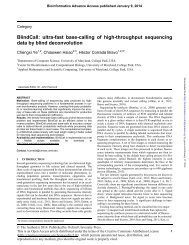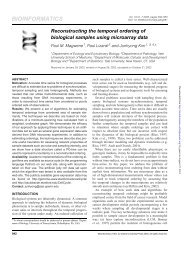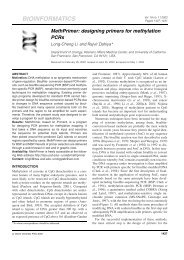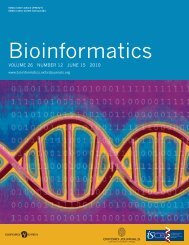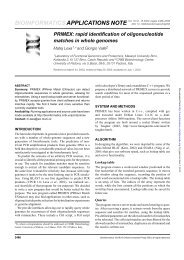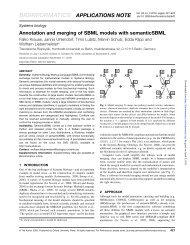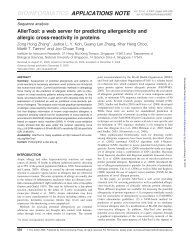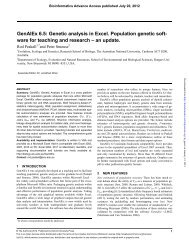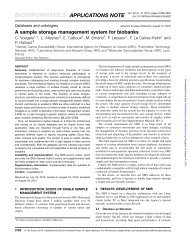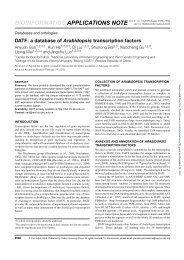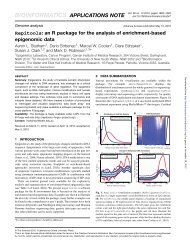SPEM: improving multiple-sequence alignment with sequence ...
SPEM: improving multiple-sequence alignment with sequence ...
SPEM: improving multiple-sequence alignment with sequence ...
Create successful ePaper yourself
Turn your PDF publications into a flip-book with our unique Google optimized e-Paper software.
Zhou and Zhou<br />
Table 2. Alignment accuracies based on SPS scores given by several methods on the SABmark 1.63 benchmark for <strong>multiple</strong> <strong>sequence</strong><br />
<strong>alignment</strong>.<br />
2 b<br />
Method ClustalW T-Coffee MUSCLE 6.0 ProbCons SP<br />
<strong>SPEM</strong> c<br />
Superfamily (462) 49.9 54.8 54.8 56.2 65.7 67.0<br />
Twilight (236) 21.9 27.4 26.3 29.2 43.5 43.9<br />
All (698) 40.4 45.5 45.2 47.1 58.2 59.2<br />
p-value d<br />
5.6×10 −112<br />
1.5×10 −96<br />
2.3×10 −85<br />
3.8×10 −83<br />
8.3×10 −6<br />
-<br />
a All results for other established methods were done locally <strong>with</strong> their latest versions.<br />
b Pairwise <strong>alignment</strong> by SP 2 , this work.<br />
c Multiple <strong>alignment</strong> by <strong>SPEM</strong>, this work.<br />
d The p-value indicates the significance of the difference in <strong>alignment</strong> accuracies between <strong>SPEM</strong> and a given method for all datasets. A<br />
p-value of >0.05 indicates a non-significant difference.<br />
Table 3. Alignment accuracies based on SPS scores given by several methods on the PREFAB 4.0 benchmark (1682 families).<br />
2 b<br />
ClustalW T-Coffee MUSCLE 6.0 ProbCons SP<br />
Method a<br />
SPS 61.7 69.2 69.6 70.5 77.0<br />
p-value c<br />
3.9×10 −142<br />
2.4×10 −21<br />
1.6×10 −55<br />
4.5×10 −16<br />
-<br />
a All results for other established methods were done locally <strong>with</strong> their latest versions.<br />
b This work. Due to the limitation of computational resource, the results for <strong>SPEM</strong> are not available.<br />
c The p-value indicates the significance of the difference in <strong>alignment</strong> accuracies between <strong>SPEM</strong> and a given method. A p-value of >0.05<br />
indicates a non-significant difference.<br />
3 RESULTS<br />
Test Set 1: BAliBase<br />
BAliBase benchmark (Thompson et al., 1999) contains five reference<br />
sets. Different sets were designed to test different aspects<br />
of <strong>alignment</strong> methods. Set 1 is made of approximately equidistant<br />
<strong>sequence</strong>s; Set 2, a family <strong>with</strong> orphan <strong>sequence</strong>s; Set 3, divergent<br />
families; Set 4, <strong>sequence</strong>s <strong>with</strong> large N/C terminal insertions;<br />
and Set 5, <strong>sequence</strong>s <strong>with</strong> large internal insertions. Reference <strong>alignment</strong>s<br />
are from FSSP (Holm & Sander, 1994) and HOMSTRAD<br />
(Mizuguchi et al., 1998) databases as well as manually constructed<br />
<strong>alignment</strong>s from the literature. All reference <strong>alignment</strong>s are<br />
manually-refined by BAliBase authors. The evaluation of <strong>multiple</strong><br />
<strong>alignment</strong> results is also performed by using the evaluation programs<br />
supplied <strong>with</strong> the benchmark. The average pairwise <strong>sequence</strong><br />
identity of this benchmark is 31.5%.<br />
Table 1 compares the results given by <strong>SPEM</strong> <strong>with</strong> those by<br />
several other methods along <strong>with</strong> the p-values for the difference<br />
in <strong>alignment</strong> accuracy between <strong>SPEM</strong> and a given method for the<br />
overall results. The other methods are two popular methods, ClustalW<br />
(Thompson et al., 1994) and T-Coffee (Notredame et al.,<br />
1998), a profile-profile <strong>alignment</strong> method PRALINEPSI (Simossis<br />
et al., 2005), MUSCLE 6.0 (Edgar, 1994) and the probabilistic<br />
consistency-based method ProbCons (Do et al., 2005). All these<br />
methods (except PRALINEPSI) are run locally <strong>with</strong> default settings.<br />
The results of PRALINEPSI are from Simossis et al. (2005).<br />
<strong>SPEM</strong> outperforms ClustalW and T-Coffee for all sets (3-5% in<br />
SPS scores) except Set 2. For two profile-based methods <strong>SPEM</strong> and<br />
Table 4. Alignment accuracies based on SPS and CS scores given by several methods on the HOMSTRAD dataset of 75 families of remote<br />
homologs.<br />
Method a<br />
SPS 60.7 64.9 66.0 67.7 68.0 74.9 75.5<br />
p-value d<br />
4.9×10 −15<br />
6.7×10 −13<br />
4.1×10 −8<br />
1.4×10 −9<br />
2.7×10 −9<br />
- 0.33<br />
CS 38.8 45.2 44.5 47.7 49.0 55.7 56.9<br />
p-value d<br />
1.9×10 −12<br />
2.2×10 −9<br />
9.6×10 −7<br />
3.0×10 −7<br />
4.3×10 −6<br />
- 0.16<br />
ClustalW T-Coffee PRALINEPSI b MUSCLE 6.0 ProbCons <strong>SPEM</strong> c <strong>SPEM</strong>-DSSP c<br />
a All results for other established methods (except PRALINEPSI) were done locally <strong>with</strong> their latest versions.<br />
b Results from the direct submission to the PRALINEPSI server <strong>with</strong> default setting (http://ibivu.cs.vu.nl/programs/pralinewww/).<br />
c This work. <strong>SPEM</strong>-DSSP is same as <strong>SPEM</strong> but <strong>with</strong> secondary structures extracted from known structures by DSSP.<br />
d The p-value indicates the significance of the difference in <strong>alignment</strong> accuracies between <strong>SPEM</strong> and a given method. A p-value of >0.05<br />
indicates a non-significant difference.<br />
4<br />
Downloaded from<br />
http://bioinformatics.oxfordjournals.org/<br />
by guest on November 24, 2012



